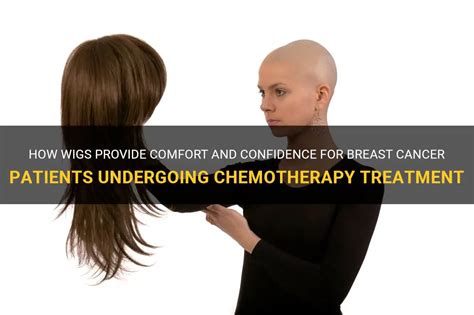Breast cancer is a prevalent disease, affecting countless women worldwide. Chemotherapy, a common treatment option, often leads to hair loss, which can be a significant emotional and psychological challenge. Wigs offer a valuable solution, not only covering the physical effects of treatment but also fostering a sense of dignity and self-esteem.

The Significance of Wigs for Breast Cancer Patients
- Emotional Well-being: Hair loss can be traumatic, impacting self-perception and confidence. Wigs restore a sense of normalcy, allowing patients to feel more comfortable in their own skin.
- Social Interaction: Wigs enable patients to participate in social activities without feeling self-conscious about their appearance. They promote social engagement and reduce isolation.
- Improved Mood: Studies have shown that wearing wigs can elevate mood and reduce distress in breast cancer patients.
Choosing the Right Wig for Your Needs
Selecting a wig that aligns with your individual preferences and needs is crucial. Consider the following factors:
- Materials: Synthetic wigs are affordable and easy to maintain, while human hair wigs offer a more natural appearance and feel.
- Color and Style: Choose a wig that complements your natural hair color and style, or opt for a transformative look.
- Comfort: Select a wig that fits comfortably on your head and doesn’t cause irritation or discomfort.
Types of Wigs for Breast Cancer Patients
Various types of wigs cater to different needs:
- Classic Cap Wigs: One-piece wigs typically made from synthetic materials or human hair, offering a secure and comfortable fit.
- Monofilament Wigs: Thin, breathable caps that create a natural scalp appearance, ideal for patients experiencing scalp sensitivity.
- Lace Front Wigs: Wigs with a lace front that mimics a natural hairline, providing a realistic and seamless look.
- Custom Wigs: Tailored to the individual’s head shape and hair color, ensuring a perfect fit and a bespoke appearance.
Benefits of Wigs Beyond Appearance
In addition to enhancing physical appearance, wigs offer therapeutic benefits:
- Confidence Booster: Wigs empower patients by giving them control over their appearance, helping them regain a sense of self-worth.
- Stress Relief: Covering hair loss can alleviate anxiety and stress associated with the visible effects of treatment.
- Improved Quality of Life: Wigs allow patients to participate in activities they may have otherwise avoided due to self-consciousness.
Table 1: Wig Types and Their Benefits
| Wig Type | Benefits |
|---|---|
| Classic Cap Wig | Secure fit, comfortable, affordable |
| Monofilament Wig | Breathable, natural scalp appearance |
| Lace Front Wig | Realistic hairline, seamless look |
| Custom Wig | Perfect fit, bespoke appearance |
Table 2: Wig Care and Maintenance Tips
| Maintenance Tip | Frequency |
|---|---|
| Wash and condition wig | Every 6-8 wears |
| Air-dry wig | Allow wig to dry completely |
| Brush wig gently | Daily, using a wide-tooth comb |
| Store wig properly | Use wig stand or box |
Common Mistakes to Avoid
- Choosing a wig that is too tight: Can cause discomfort and irritation.
- Not cleaning your wig regularly: Can lead to tangles and buildup.
- Using harsh chemicals or bleach on your wig: Can damage the wig’s fibers.
- Overbrushing your wig: Can cause breakage and reduce the wig’s lifespan.
Table 3: Tips for Wearing a Wig in Public
| Tip | Purpose |
|---|---|
| Wig Adhesive | Secure the wig and prevent slippage |
| Headband | Conceal the wig’s cap line |
| Styling Products | Enhance the wig’s natural appearance |
| Practice | Become comfortable wearing the wig |
Table 4: Support Organizations for Wig Access and Care
| Organization | Services |
|---|---|
| American Cancer Society | Wig donation program, financial assistance |
| Look Good Feel Better | Free wig consultations, styling tips |
| Hair to Stay | Wig bank for patients in need |
| The Beautiful You Foundation | Grants for wig purchases |
Additional Considerations:
- Cost: Wigs range in price depending on materials, style, and customization. Explore financial assistance programs if needed.
- Insurance Coverage: Some insurance plans may cover wigs as a medical necessity. Check with your provider for details.
- Emotional Preparation: Allow time to adjust to wearing a wig and seek support from loved ones or therapists if needed.
- Aerify: The wig’s cap should have a mesh construction to allow air to circulate and prevent overheating.
- Maintenance: A custom wig requires more maintenance than a regular wig to preserve its look and longevity.
- Styling Complexity: While most wigs come pre-styled, some may require additional styling to match your desired look.
Conclusion
Wigs are an integral part of the healing journey for breast cancer patients. They provide not only a physical solution to hair loss but also a psychological boost, fostering confidence, improving mood, and enhancing social engagement. By choosing the right wig for your individual needs and following proper care and maintenance guidelines, you can embrace your beauty and regain a sense of normalcy during this challenging time.
